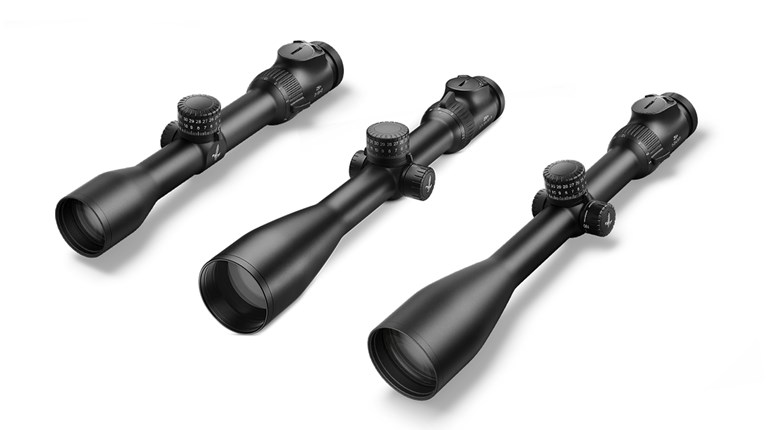** When you buy products through the links on our site, we may earn a commission that supports NRA's mission to protect, preserve and defend the Second Amendment. **

1,000 yards? Um ...
Our Leupold Optics Academy instructor looked at us over our steaming cups of coffee and told us that, later that afternoon, we were going to be shooting targets at 1,100 meters later that very afternoon. I gulped, inadvertently scalding my throat with my coffee. I'm sorry, I thought. I hate to disappoint you, but I just don't think that's going to be possible for me. Oh, I had a handful of reasons to doubt that I could do it—my lack of experience shooting past 200 yards, my rusty math skills, my astigmatism. What I was to learn in a matter of hours was that Leupold Optics Academy stands by their advertising: "Our uniquely designed academy focuses on the optic in addition to the platform it’s mounted on, and can take a shooter to a new level of understanding of the shooting system as a whole." And they can prove it. Although what I and the rest of the female outdoor writers attending absorbed was essentially a five-day course boiled down into a day, each one of us hit that 1,100-meter target. Here are six things I learned that day:
1. Yes, good glass does make a difference.
Although lower-quality optics can be fine for shorter distances and in bright conditions, when it comes to what my colleagues here at NRA like to call "taking a long poke," high-quality glass really does help. At the Academy, one of the first things we did was look downrange first with the optic we were going to be using on our bolt-action .308s, and then with a few different competitors' optics. I quickly realized that I was going to be shooting at a target that was difficult to see with my (admittedly substandard) naked eyes, and that I was really going to need to rely on my optic to give me the sharpest, clearest picture at a distance...and that the Leupold VX-6 riflescope I had was doing the best job out of all of the others.
2. Hold still. No, more still than that.
The second thing our instructor had us do was to practice repeatedly lying down in the prone position, socking the rifle's butt into the pocket of our shoulders, and putting our face in exactly the same place on the stock, every time. I quickly learned that shifting or tilting my head just a little bit was enough to completely obscure my field of vision in the scope. However, once I got the hang of precisely where the adjustable cheekpiece needed to be firmly resting against my cheekbone, I began to adapt. I also learned that I never knew just how much I fidget and jitter until I forced myself to stop.
3. The math part is really not that big of a deal.
It's not that math isn't important to the science of ballistics—of course it is. However, you personally don't have to do it. There are tons of ballistic apps you can download to your computer or mobile device that will do all of the work for you. You plug in the cartridge caliber, bullet weight, temperature, humidity and range and it tells you where to hold.
4. Wind, on the other hand, is a big deal.
We didn't go straight to 1,100 meters, of course. The first few shots were at 300, 400, 500...and so far, everything was working perfectly. Without shifting my head a millimeter, I'd reach up and dial in to each new target, take a deep breath, let it out, squeeze the trigger...and then be rewarded (at noticeably longer and longer intervals—it isn't that often that we're reminded so definitively that sound has a speed) with a snappy ping as my bullet struck home on the steel targets. I started being able to "feel" when I'd made a good shot. And then, at 800 meters, I did everything right, and...nothing. I actually felt cheated. "Sorry," murmured my spotter. "The wind out there is going in the other direction." The wind in question was probably no more than a few miles an hour—a barely noticeable breeze. But at that distance, it was enough to knock my bullet off-course.
5. Everything but you, the gun and the target disappears.
It really is quite Zen, once you get the hang of it: The world dials down into the sensation of the cheekpiece digging into your face, the view through the riflescope, the yielding of the trigger beneath the pad of your finger, the buttstock pushing into your shoulder, the wind drying the sweat on the back of your neck, the tidal rhythm of your breath moving in and out. The rifle begins to feel like part of your body, the bullets impacting 1,000 meters away as if driven there by the force of your will. Everything else is gone.
6. Until you stand up again, that is. Then you're going to want to do some stretching.
Although I'd barely twitched a muscle for an hour or longer, when we finally stood up to try some offhand shooting at 100 yards with professional shooter Jessie Duff (pictured above), I was as achy as if I'd walked as far as each of my bullets had traveled...uphill. Still, I walked away from the class both proud and astonished that yes, I could "take a long poke" and hit targets 12 football fields away.
The science of long-range shooting can sound pretty daunting, but it's something that, with the right equipment, information and instruction, even a beginner can do. Want to know more? Click here for a comprehensive and detailed guide to long-range shooting for newbies from Shooting Illustrated's Richard Mann.
1. Yes, good glass does make a difference.
Although lower-quality optics can be fine for shorter distances and in bright conditions, when it comes to what my colleagues here at NRA like to call "taking a long poke," high-quality glass really does help. At the Academy, one of the first things we did was look downrange first with the optic we were going to be using on our bolt-action .308s, and then with a few different competitors' optics. I quickly realized that I was going to be shooting at a target that was difficult to see with my (admittedly substandard) naked eyes, and that I was really going to need to rely on my optic to give me the sharpest, clearest picture at a distance...and that the Leupold VX-6 riflescope I had was doing the best job out of all of the others.
2. Hold still. No, more still than that.
The second thing our instructor had us do was to practice repeatedly lying down in the prone position, socking the rifle's butt into the pocket of our shoulders, and putting our face in exactly the same place on the stock, every time. I quickly learned that shifting or tilting my head just a little bit was enough to completely obscure my field of vision in the scope. However, once I got the hang of precisely where the adjustable cheekpiece needed to be firmly resting against my cheekbone, I began to adapt. I also learned that I never knew just how much I fidget and jitter until I forced myself to stop.
3. The math part is really not that big of a deal.
It's not that math isn't important to the science of ballistics—of course it is. However, you personally don't have to do it. There are tons of ballistic apps you can download to your computer or mobile device that will do all of the work for you. You plug in the cartridge caliber, bullet weight, temperature, humidity and range and it tells you where to hold.
4. Wind, on the other hand, is a big deal.
We didn't go straight to 1,100 meters, of course. The first few shots were at 300, 400, 500...and so far, everything was working perfectly. Without shifting my head a millimeter, I'd reach up and dial in to each new target, take a deep breath, let it out, squeeze the trigger...and then be rewarded (at noticeably longer and longer intervals—it isn't that often that we're reminded so definitively that sound has a speed) with a snappy ping as my bullet struck home on the steel targets. I started being able to "feel" when I'd made a good shot. And then, at 800 meters, I did everything right, and...nothing. I actually felt cheated. "Sorry," murmured my spotter. "The wind out there is going in the other direction." The wind in question was probably no more than a few miles an hour—a barely noticeable breeze. But at that distance, it was enough to knock my bullet off-course.
5. Everything but you, the gun and the target disappears.
It really is quite Zen, once you get the hang of it: The world dials down into the sensation of the cheekpiece digging into your face, the view through the riflescope, the yielding of the trigger beneath the pad of your finger, the buttstock pushing into your shoulder, the wind drying the sweat on the back of your neck, the tidal rhythm of your breath moving in and out. The rifle begins to feel like part of your body, the bullets impacting 1,000 meters away as if driven there by the force of your will. Everything else is gone.
6. Until you stand up again, that is. Then you're going to want to do some stretching.
Although I'd barely twitched a muscle for an hour or longer, when we finally stood up to try some offhand shooting at 100 yards with professional shooter Jessie Duff (pictured above), I was as achy as if I'd walked as far as each of my bullets had traveled...uphill. Still, I walked away from the class both proud and astonished that yes, I could "take a long poke" and hit targets 12 football fields away.
The science of long-range shooting can sound pretty daunting, but it's something that, with the right equipment, information and instruction, even a beginner can do. Want to know more? Click here for a comprehensive and detailed guide to long-range shooting for newbies from Shooting Illustrated's Richard Mann.







































